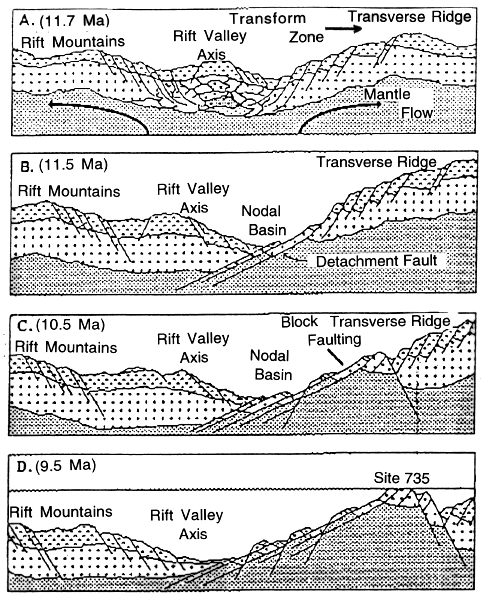

Figure 176-3. Temporal cross sections across the Southwest Indian Ridge rift valley drawn parallel to the spreading direction (not across the fracture zone, but parallel to it), showing the postulated tectonic evolution of the transverse ridge and Hole 735B (Dick et al., 1991). The sequential sections are drawn at about 18 km from the transform fault. Crust spreading to the right passes into the transverse ridge and spreads parallel to the transform valley. Crust spreading to the left spreads into the rift mountains of the Southwest Indian Ridge parallel to the inactive extension of the Atlantis II Fracture Zone.
A. Initial symmetric spreading, possibly at the end of a magmatic pulse. Late magmatic brittle-ductile deformation occurs because of lithospheric necking above (and in the vicinity of whatever passes for a magma chamber at these spreading rates). Hydrothermal alteration at high temperatures accompanies necking and ductile flow in subsolidus regions.
B. At some point, the shallow crust is welded to the old, cold lithosphere to which the ridge axis abuts, causing formation of a detachment fault, and nodal basin, initiation of low-angle faulting, continued brittle-ductile faulting, and amphibolite-facies alteration of rocks drilled at Hole 735B.
C. and D. Block uplift of the rift mountains at the ridge-transform corner forms a transverse ridge enhanced by regional isostatic compensation of the local negative mass anomaly at the nodal basin. Initiation of the block uplift terminates the extension driving cracking, and drastically reduces permeability in the Hole 735B rocks, effectively terminating most circulation of seawater and alteration. Greenschist-facies retrograde alteration continues along the faults on which the block is uplifted to account for the greenschist-facies alteration that predominates in dredged gabbros.